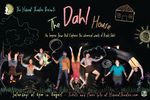Difference between revisions of "The Dahl House"
(→Improv Stylings: added narrative and tech elements) |
(→Format: added player count) |
||
| Line 20: | Line 20: | ||
The players then spin a Dahl-inspired narrative involving the word. After an intermission, the protagonist starts asleep on stage, and the players create a dream sequence through improvised dance, opening the second half to the protagonist waking up. | The players then spin a Dahl-inspired narrative involving the word. After an intermission, the protagonist starts asleep on stage, and the players create a dream sequence through improvised dance, opening the second half to the protagonist waking up. | ||
The full cast of eight players, modulo a few absences, played in each show. | |||
=== Improv Stylings === | === Improv Stylings === | ||
Revision as of 02:48, 13 March 2015
| The Dahl House | |
|---|---|
| Theater | The Hideout Theatre |
| Directed by | Valerie Ward |
| Assistant Director(s) | Jayme Ramsay |
| Cast | |
| Crew | Rachel Posey Austin (sound) |
| Run | Aug 2014 |
The Dahl House was the August 2014 student mainstage production at The Hideout Theatre.
Summary
Publicity Blurb
From the show announcement:
"Improvised stories inspired by Roald Dahl. British children’s fantasy with a distinctly fizz-wizzing flair."
Format
After opening to a choreographed dance, the players line up to the front of the stage at the summoning of the class' teacher (played by Valerie). The audience is addressed as observers from an English department of educational excellence (with an appropriately extensive Dahl-ian name) and asked for an initial letter. The players go down the line, adding letters to form an improvised word, then providing a definition word-at-a-time. The teacher then releases the students to playtime, kicking off the narrative.
The players then spin a Dahl-inspired narrative involving the word. After an intermission, the protagonist starts asleep on stage, and the players create a dream sequence through improvised dance, opening the second half to the protagonist waking up.
The full cast of eight players, modulo a few absences, played in each show.
Improv Stylings
The players translated elements of Dahl's distinctive narrative and linguistic style to stage. These elements include fantastical or magical abilities, invented words, and dark or dangerous world. The players also used extensive scene-painting and other direct-addressing of the audience to mirror the style of a written narrative that communicates directly through the prose standing between quotations.
The narrative followed a single (child) protagonist; no one else was guaranteed to survive. Villains, or the merely nasty, were often plentiful. Costume pieces helped differentiate characters; these were often brought in through explicit scene-painting simultaneously with an actual, physical endowment of clothing.
The opening and post-intermission dances had setpiece songs; the rest of the show had improvised scoring from a playlist. The narrative had improvised lights throughout.
Media
Photos
- Photoset by Warren Henderson of a show.
- Photoset by Peter Rogers of the 8/16/14 show.
More Information
- The show announcement on the Hideout's web site.
